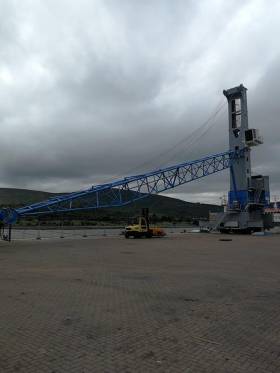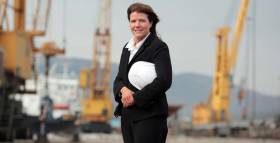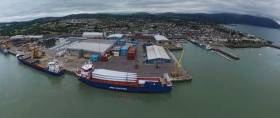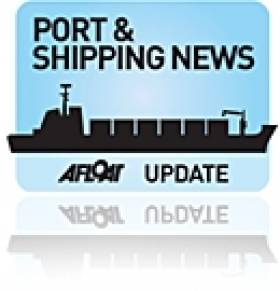Displaying items by tag: Warrenpoint Port
Carlingford Lough Dredging Proposal Campaigners Claim Could Bring 'Nuclear Material'
#Ports&Shipping - On both sides of the border, The Irish News writes campaigners are objecting to plans to deposit dredged material within Carlingford Lough, claiming it would bring nuclear substances into the bay.
As covered on Afloat.ie, Warrenpoint Port is proposing to move the placing of dredged material collected during its regular operations and carried out in order to maintain clear access for vessels - from 16 miles out at sea to within the lough.
The port has earmarked a site between Greencastle and Cranfield for the plans.
The Carlingford Ferry crosses close to the proposed zone, from Greencastle in Co Down to Greenore in Co Louth.
For further reading, click here.
#Ports&Shipping - A new date has been set by Warrenpoint Port (Monday 15th October) for a public drop-in event to allow members of the public and other stakeholders to learn more about proposed changes to how dredged material from the harbour is dealt with in Carlingford Lough.
The open drop-in event day is to take place at Warrenpoint Town Hall from 3pm to 6pm. The event follows the postponement on health and safety grounds due to adverse weather caused by Storm Ali, of the previously planned meeting in the same venue as also posted here on Afloat which focused on a bulk-carrier call from the Black Sea.
Clare Guinness, CEO, Warrenpoint Port said: “We are pleased to announce a new date for the public to join with us at Warrenpoint Town Hall to find out more about proposals for a new placement site for dredged material.
“We are also extending the closing date for comments on this stage of the consultation process to 31st October.
“In our role as a custodian of the marine environment, we want to hear the views of all stakeholders before any plans are put into action.”
It is proposed that dredged material, is placed at a site in the mouth of Carlingford Lough between Cranfield Point and Greencastle.
A number of surveys, studies and assessments will be undertaken to determine the suitability of the location, the results of which will be made publicly available and will be subject to further public consultation.
The public drop-in event will be attended by staff from Warrenpoint Port and its consultants Royal HaskoningDHV.
More information is available at the port's website here while comments can be made by contacting [email protected].
Ship Snapshot: Bulker From Black Sea Berths With Animal Feed In Warrenpoint Port
#Ports&Shipping - A Panamanian flagged bulk-carrier loaded with 18,000 tonnes of animal feed arrived in Warrenpoint Port, Co. Down following a voyage from a Black Sea port in Romania, writes Jehan Ashmore.
The bulker, Fanaria according to Warrenpoint Port was assisted onto its berth using two tugs on 11 September. Afloat has identified the tug at the stern as Mourne Shore, the veteran vessel dating to 1964 was formerly the German serving Bugsier 29. Working the mooring lines at the bulker's bow is understood to be the tug's fleetmate, Mourne Valley.
Warrenpoint Port which is Northern Ireland's second largest port including Seatruck's ro-ro freight services to Heysham, England. In addition to handling containers, dry-bulk and break-bulk cargoes. The port as previously reported this month, announced a new proposal for dredging operations in Carlingford Lough.
The port sought views and comments from the public and key stakeholders on the proposed changes to how dredged material from the harbour is dealt with. A public consultation was scheduled to have taken place this day last week at Warrenpoint Town Hall.
On the southern shores of Carlingford Lough is Greenore Port, Ireland's only privately operated port. Last year saw the launch of the first ever car-ferry service on the cross-border lough linking the Co. Louth port with Greencastle in Co. Down.
Public Consultation: Warrenpoint Port Asks to Hear Views on Dredging Proposal
#Ports&Shipping - The second largest port in Northern Ireland, Warrenpoint Port, is inviting members of the public and other key stakeholders to comment on proposed changes to how dredged material from the harbour is dealt with.
The Co. Down port currently carries out a major dredging programme every two to five years with material disposed of in the Irish Sea.
However, new plans have been put forward to carry out dredging on a more regular but smaller scale, with material placed at a site in the mouth of Carlingford Lough between Cranfield Point and Greencastle.
Clare Guinness, CEO, Warrenpoint Port said: “In order for the Port to continue to support maritime trade successfully, it must ensure a sufficient water depth is maintained to allow for the safe berthing of vessels, which it does through dredging.
“In anticipation of a rise in trade over the coming years, and to ensure the Port continues to thrive as an economic driver to the local region, a new site for the disposal of dredged material is being proposed within the mouth of Carlingford Lough.
“This is also in line with current thinking that dredged material should be deposited as close as possible to source.
“In our role as a custodian of the marine environment, we want to hear the views of all stakeholders, including members of the public, before any plans are put into action.”
A number of surveys, studies and assessments will be undertaken to determine the suitability of the location between Cranfield Point and Greencastle, including marine ecology and sediment surveys, geophysical surveys, and hydrodynamic and sediment transport modelling.
A public drop-in consultation event will take place at Warrenpoint Town Hall on Wednesday 19th September from 4pm to 7pm. There will be an opportunity to discuss the proposed disposal site and the environmental assessment process with Port staff and its consultants Royal HaskoningDHV.
New £3m Crane At Warrenpoint Port Scheduled to Begin Operations in September
#Ports&Shipping- Work on the construction of a new £3m crane at Warrenpoint Port began last month following the investment as part of a bid to facilitate further growth ahead of Brexit and beyond at Northern Ireland’s second largest port.
The crane, which is supplied by Finnish manufacturer Konecranes, will significantly improve efficiency by reducing loading and unloading times with the ability to lift 100 tonnes up to 42 metres above sea level.
Clare Guinness, CEO, Warrenpoint Port commented: “It is an exciting time for Warrenpoint Port as construction of our latest crane addition begins, enabling us to further improve our already high standards of service to customers.
“The purchase of the Model 3 Mobile Harbour Crane, which itself will weigh 300 tonnes, is an example of our commitment to invest in our operations, thereby boosting prosperity in the area for both local people and businesses.”
Earlier this year, Warrenpoint Port announced a major 25-year growth plan which anticipates core roll on, roll off, freight to rise by up to 80% by 2040, regardless of the outcomes of Brexit negotiations.
Clare continued: “We are fully prepared for the forecasted growth in freight shipping, with two other cranes also undergoing refurbishment.”
The crane will take three weeks to assemble and a further two to commission before entering service in September.
When complete, it will help the Port, which deals with a variety of goods including steel and timber and offers a full range of shipping services further build on increasing levels of business. In 2017, the Port handed a record 3.56 million tonnes of cargo valued at £6.2 billion.
Warrenpoint Port Purchases €3m Crane
Warrenpoint Port is to invest £3 million in the purchase of a new crane and the refurbishment of two further cranes at the harbour.
The investment, which will significantly improve efficiency and increase capacity, forms part of a major drive to facilitate continued growth in trade at Northern Ireland’s second largest port.
Clare Guinness, CEO, Warrenpoint Port commented: “We are delighted to announce this major investment in new and refurbished plant for the harbour that will enable us to maintain our already high standards of service to customers and bring us closer to our targeted growth over the coming years.”
The new crane will be built and supplied by Finnish manufacturer Konecranes at its site in Dusseldorf, Germany.
The Model 3 Mobile Harbor Crane, which itself will weigh 300 tonnes, will have the capacity to lift loads up to 100 tonnes to a height of 42m above quay level.
Clare added:
“The new crane will significantly boost operations at Warrenpoint by allowing for the speedier loading and unloading of goods, as well as reducing downtime.
“We are also investing significant capital to refurbish two of our existing cranes at the Port to ensure they will continue to serve our customers for many years to come.
“The investments are being made to facilitate further growth at the Port as we gear up for trade in the post-Brexit era.
“They will also strengthen our position as a catalyst for economic growth in our community as we aim to boost the prosperity of local people and businesses.”
Warrenpoint Port, which last year handled a record 3.56 million tonnes of cargo, valued at £6.2 billion, deals with a broad spectrum of goods including grain, timber, steel and cement and offers a full range of services including container and freight.
Earlier this year, the Port unveiled a major 25-year growth plan which forecast a continued growth in trade following Brexit.
Authorities at the Port, anticipate a significant increase in trade over the coming decades with core roll on, roll off, freight expected to rise by up to 80% by 2040.
Founded more than 80 years ago, Konecranes is one of the world’s leading manufacturers of heavy lifting equipment serving the manufacturing and process industries, shipyards, ports and terminals.
Warrenpoint Port Handles Biggest Cargo of Steel
#Ports&Shipping - Warrenpoint Port in Co. Down has recently handled its biggest cargo of steel.
The record discharge of 7,000 tonnes of steel profiles was carried out by ships agent, Armagh Logistics.
The steel had been loaded in Turkey from where cargoship Comet sailed to Carlingford Lough.
On the same day, (Tuesday last week), it was a busy scene as all berths at Warrenpoint were occupied by other albeit smaller short-sea traders.
In addition to a routine call of a 'P class ro-ro freight ferry from Seatruck. The Irish Sea freight shipping company has among its network, a route to Heysham, Lancashire (see related report).
Warrenpoint Harbour Authority (WHA) has published an Economic Impact Assessment which has highlighted the port’s value to the local economy and confirmed its position as the second-largest port in Northern Ireland. The report carried out by independent economist, Ryan Hogg, working alongside Richard Johnston, an Associate Director in the Ulster University Economic Policy Centre and Board member of WHA, concludes that over the last decade the port has generated over £61m of GVA and sustained over 1550 full-time equivalent job years for the local economy. GVA also grew at a compound rate of 4.1% in this same period compared to a NI average of 0.27% highlighting the growing resilience and importance of the port to the region.
The report also confirmed that 2016 was a record year for the port, handling 3.5m tonnes of freight, valued at £6.2bn. It highlighted that currently, over 200 people work in the port every day with the Harbour Authority employing 65 directly. The multiplier effect further generates significant job numbers in the local economy. In 2016 alone, the port generated £7.3m in Gross Value Added for the NI economy through on-site activity, via its local supply chain and employees wage expenditure. In addition, companies that trade through the Port generate a further £25m of GVA for the local economy plus benefits for the Irish and UK economies.
Speaking about the report, Stan McIlvenny, the Chairman of Warrenpoint Harbour Authority said “We are delighted to report the significant and growing contribution that Warrenpoint Port makes to the local economy- both directly and indirectly. Importantly, however, we are not standing still and the Board, staff, local stakeholders and industry experts are working together to develop shared plans for the future of the Port that will ensure that it thrives and grows, contributing even more to the economy of the future.”
The report also highlighted the strategically important nature of the port and its growing significance as a key component of Northern Ireland’s economic infrastructure. Local companies trade through the Port with customers in GB and Ireland, but also more broadly across the world including with Spain, Italy, Sweden, Belgium, Germany, the Ukraine and the Americas. It acts as a valuable gateway to export sales and as an import destination for goods from across the world destined for the island of Ireland. It also has made some inroads on the growing cruise tourism market – with each cruise ship visit to the port estimated to generate a potential £18,000 of GVA to the local economy.
The Port also promotes social initiatives by supporting charitable causes such as Mission for Seafarers and Carlingford Lough Sailability to helping those in need within the Marine Sector and Warrenpoint. Staff also take a key role in engaging with the local community through School visits, Sentinus Projects and by sponsoring several sports clubs and festivals.
The report also considers the challenges facing the port and chief among them is the fall-out of Brexit and what trading arrangements are established between the UK and the EU and other countries. Another challenge identified, to ensure the port remains competitive in the future, is the delivery of the Newry Southern Relief Road which would provide a more direct route for freight from across the island of Ireland entering and exiting the Harbour.
Peter Conway, the Chief Executive commented “The Port has been part of the fabric of society in Warrenpoint for hundreds of years and is an important catalyst for economic development in the region. It is a local business with international reach and the income generated from trading allows the Harbour and those working in the team to support a range of local initiatives and social enterprises, both financially and by giving their time. I’m keen that the Harbour develops and continues to support and grow the local economy and we hope that with strategic investment in projects such as the Southern Relief Road, we can continue to be a key component of the local and regional economy, whatever Brexit brings.”
Fair Winds Blow for Warrenpoint Port Trade
#WarrenpointPort- If the recent experience of Northern Ireland's harbour in Warrenpoint is anything to go by, the region is well on its way to economic recovery as the Co. Down port is showing a rise in trading activity.
With imports such as animal feeds and exports including bulk cement and building materials, the Port of Warrenpoint recorded a doubling of pre-tax profits to around £850,000 in 2013.
There are now plans for a new yachting marina, increased cruise ship activity and even the possibility of taking over facilities in Greenore, Co. Louth, on the other side of the border.
The Belfast Telegraph has more to report, click HERE





































































